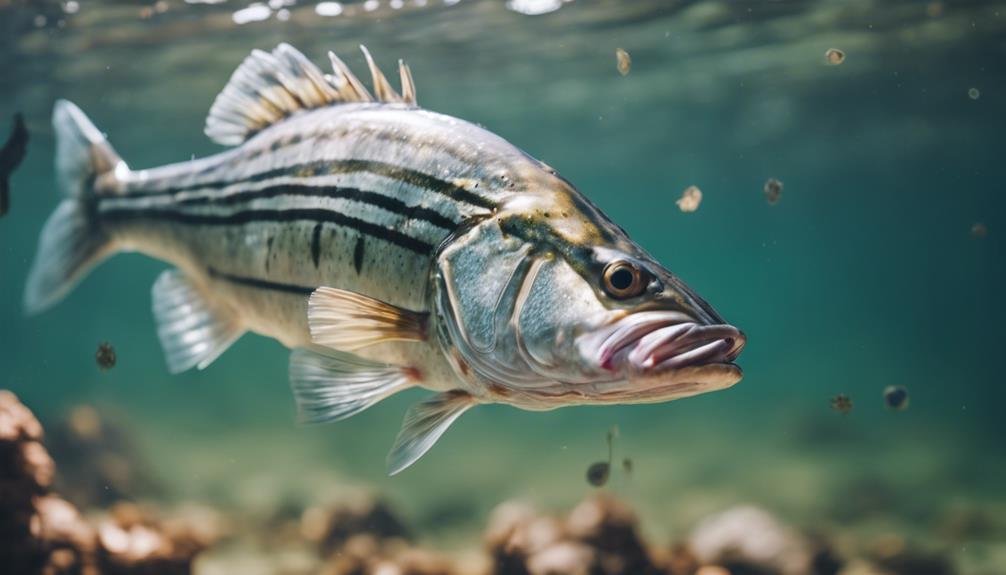Choosing the right bait can make all the difference when you’re chasing striped bass. You might wonder if live bait like bunker or eels will outshine clams or mackerel. Each has its unique appeal, from the strong scent of bunker to the lifelike action of eels. But what about artificial lures? Soft plastics, jigs, and spoons also have their time and place. Are you maximizing your chances by using the best bait for the situation? Let’s explore which options could elevate your striped bass angling game.
Key Takeaways
- The live bunker’s strong scent makes it highly effective in attracting striped bass.
- Eels’ natural swimming action is particularly enticing to striped bass.
- Clams, especially soft-shelled or surf clams, have a strong scent that attracts striped bass.
- Fresh mackerel, cut into strips or chunks, mimics natural prey and attracts striped bass.
- Soft plastics like Slug-Gos and super flukes offer lifelike action that striped bass find irresistible.
Live Bait Options
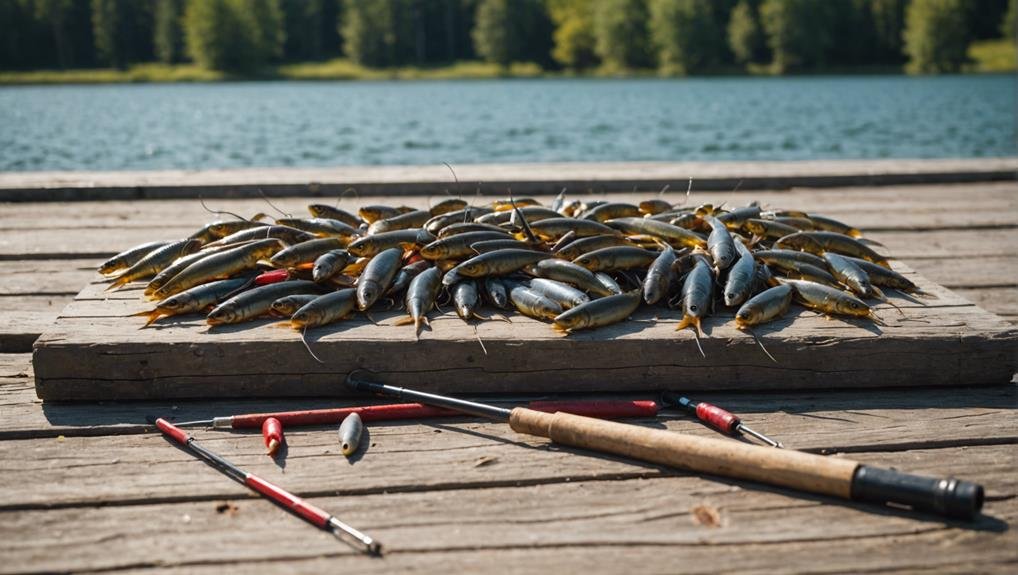
When targeting striped bass, it is vital to select live bait that closely mimics their natural prey. Depending on what the striped bass are actively feeding on, you’ll want to choose live bait like bunker, shad, herring, eels, worms, clams, or mackerel. The key is to match the hatch, meaning your bait should resemble the natural prey in appearance and behavior.
Live bait needs to be lively and healthy to attract striped bass effectively. When selecting bait, make sure it’s fresh and vibrant. For instance, eels are popular because their wriggling action is irresistible to bass. Similarly, shad and herring are excellent options, especially when these fish are abundant. Worms and clams can also be very effective, particularly in coastal regions where these are native food sources.
Experimenting with different live bait options can help determine what works best under varying conditions. Don’t hesitate to try mackerel or swap out various bait types during your fishing trip. High-quality live bait is essential for increasing your chances of hooking big striped bass and making your outing successful.
Using Bunker (Menhaden)
Using a bunker, also known as menhaden, can be incredibly effective when targeting striped bass due to its strong scent and oil. Striped bass are naturally drawn to the rich aroma that bunker emits, making it a go-to choice for many anglers.
You can use a bunker in various forms to increase your chances of a successful catch. Live menhaden is an excellent option if you can get your hands on it. Rigging live bait on your hook will mimic the natural prey of striped bass, enticing them to bite.
However, fresh or frozen bunker can also work wonders. Cutting the bunker into chunks or fillets releases the strong scent and oil, creating a trail that striped bass find irresistible.
When using cut chunks or fillets, rig them properly on your hook. This presentation helps the bait stay secure while allowing the scent to disperse in the water.
Whether you choose live menhaden or cut pieces, bunker remains one of the most effective baits for striped bass. You’ll likely see more bites and a more successful fishing trip by leveraging its natural attributes and presenting it correctly.
Fishing With Eels

Fishing with eels is a highly effective method for landing striped bass due to their natural swimming action, which stripers find irresistible. You’re mimicking one of their favorite prey items when you use live eels as striped bass bait. Keeping them lively and healthy is the key to success with fishing with eels.
To maximize your chances of hooking a striper, follow these steps:
- Rigging: Use circle hooks to rig live eels. Insert the hook through the lower jaw and out through the upper jaw. This setup guarantees the eel stays alive longer and swims more naturally.
- Presentation: Cast your bait fishing rig into areas where striped bass are known to hunt. Let the live eel’s movement do the work, enticing stripers with its lifelike action.
- Handling: Keep eels in a cool, aerated bait bucket until ready to use them. The livelier the eel, the more attractive it will be to striped bass.
Clams as Bait
Clam bait’s strong scent is a surefire way to attract striped bass to your fishing spot. When you’re bait fishing, surf clams are a top choice due to their potent aroma and effectiveness. Clams can be cut into strips or chunks, making them versatile for various fishing techniques. Their strong scent travels through the water, drawing striped bass from a distance.
Proper presentation and placement are vital. Ensuring your clam bait is securely attached to your hook increases the chances of a successful catch. It’s all about making your bait as enticing as possible, and clams do just that. Let’s break down some key points:
| Aspect | Details | Tips |
|---|---|---|
| Type of Clams | Soft-shelled or surf clams | Opt for fresh, high-quality clams |
| Preparation | Cut into strips or chunks | Use a sharp knife for clean cuts |
| Scent | It emits a strong scent | Use in areas with strong currents |
| Presentation | Securely attach to the hook | Ensure it looks natural underwater |
| Placement | Position in likely bass areas | Near structures or drop-offs |
Using clams as bait is a tried-and-tested method. By focusing on the right clams, preparation, and strategic placement, you’ll be well on landing that prized striped bass.
Effective Mackerel Use
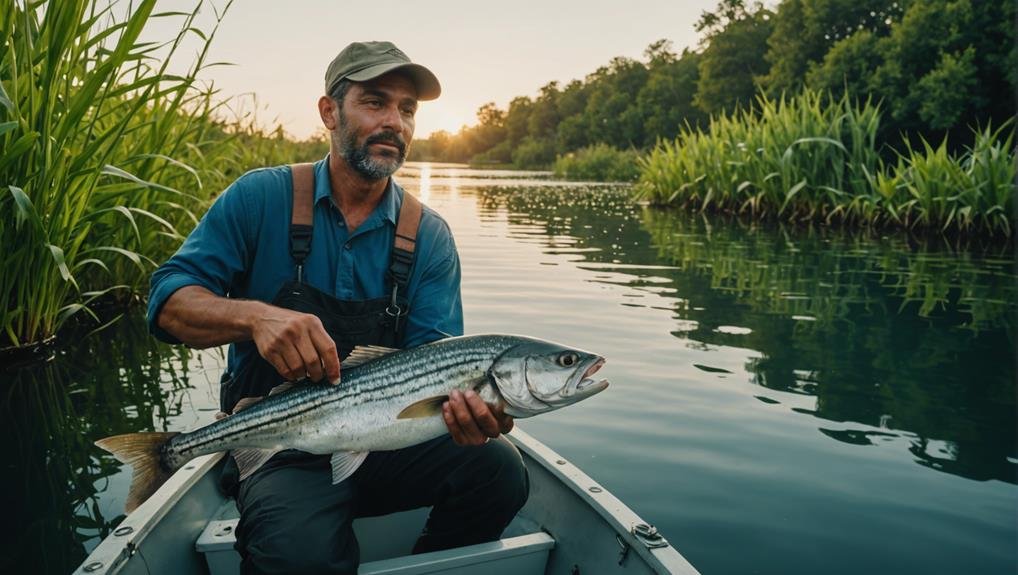
Mackerel is a powerhouse bait that greatly enhances your chances of catching striped bass. Its strong scent and oily texture make it irresistible to striped bass, especially when used fresh. To maximize your success, you’ll want to cut the mackerel into strips or chunks, which effectively mimic the natural prey of these fish.
Here are three key tips to make the most out of mackerel as bait:
- Use Fresh Mackerel: Fresh mackerel emits a strong scent that attracts striped bass more effectively than frozen or old bait. Always opt for the freshest mackerel you can find.
- Cut into Strips or Chunks: Cutting the mackerel into strips or chunks helps mimic the natural prey that striped bass are used to hunting. This presentation can trigger more strikes.
- Proper Presentation: How you present the mackerel is essential. Make sure to hook the strips or chunks in a way that allows them to move naturally in the water, increasing their appeal to striped bass.
Artificial Lures
Artificial lures offer a versatile and effective way to target striped bass in various fishing conditions. Using the right lure can make a significant difference when you’re out on the water.
Topwater lures like poppers and spooks are excellent for enticing striped bass to strike on the surface, especially during low light conditions at dawn or dusk. Soft plastics with jig heads are another great option; they mimic natural prey and can be used in different fishing situations, adapting to the fish’s behavior and water clarity.
Metal lip swimmers like the Gibbs Danny Surface Swimmer are perfect for effectively trolling and covering large areas. These lures work well in clear water and must attract fish from a distance. Needlefish lures, like the Super Strike Super N Fish, are particularly productive in various environments, especially when targeting striped bass feeding on slender baitfish.
When choosing artificial lures, it’s essential to consider the time of day, water clarity, and fish behavior. Matching your lure selection to these factors can greatly increase your chances of success.
Topwater Lures
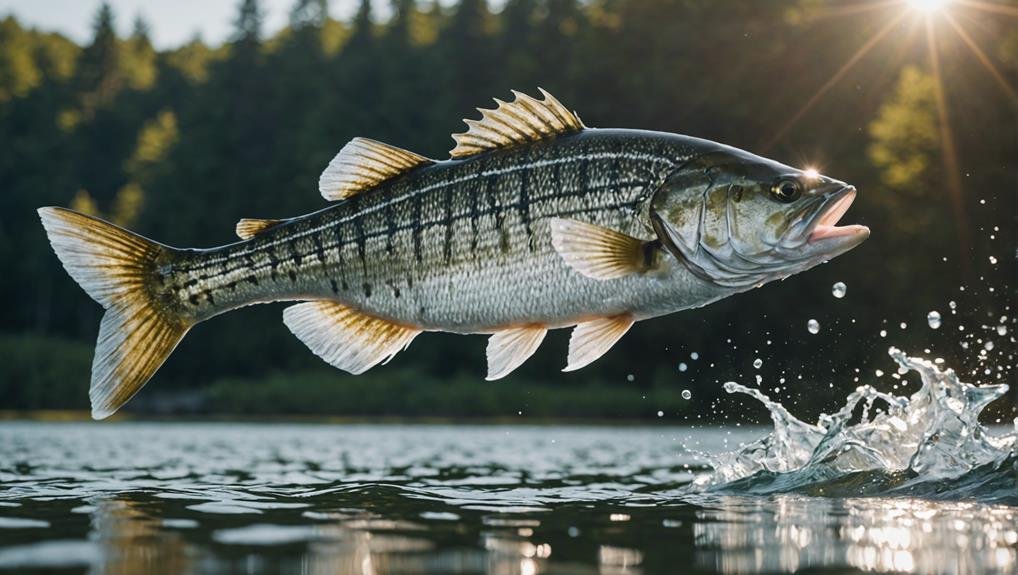
Topwater lures can create an exhilarating experience as you watch striped bass explode on the surface to strike. As water temperatures rise, these lures become especially effective. Topwater lures like the Heddon Spook, with its ‘walk the dog’ action, are great for attracting striped bass. These lures will be a thrilling and productive option in your fishing arsenal.
To maximize your success with topwater lures, consider the following tips:
- Light-colored lures: Light-colored lures, such as yellow or white, are particularly effective in the early morning. Striped bass are more likely to notice these hues against the dim light of dawn.
- Dark-colored lures: At night, darker lures like black work best. They create a strong silhouette against the night sky, making them easier for striped bass to spot.
- Soft plastics: While we’ll dive deeper into soft plastics later, know that fishing these weightless as a subtler topwater option can be enticing for striped bass.
Soft Plastics
Soft plastics are a versatile and highly effective bait for catching striped bass. Whether using Slug-Gos, super flukes, or the durable Cobra Baits Sad Shad, these lures can dramatically increase your chances of landing a big striper. Soft plastics are known for their lifelike action, which makes them irresistible to striped bass.
When choosing your soft plastics, pay close attention to color selection. Herring and black are particularly productive choices. Herring-colored baits effectively mimic the natural prey of stripers, while black soft plastics can resemble eels, another favored food source. Black soft plastics can be especially successful in low-light conditions or murky waters.
One effective strategy is to fish your soft plastics near the bottom, where striped bass often hunt. This approach increases the likelihood of your bait being noticed and attacked by a hungry stripper. Ensure your soft plastic is rigged correctly to maintain its action and appeal as it moves through the water.
Jigs and Spoons
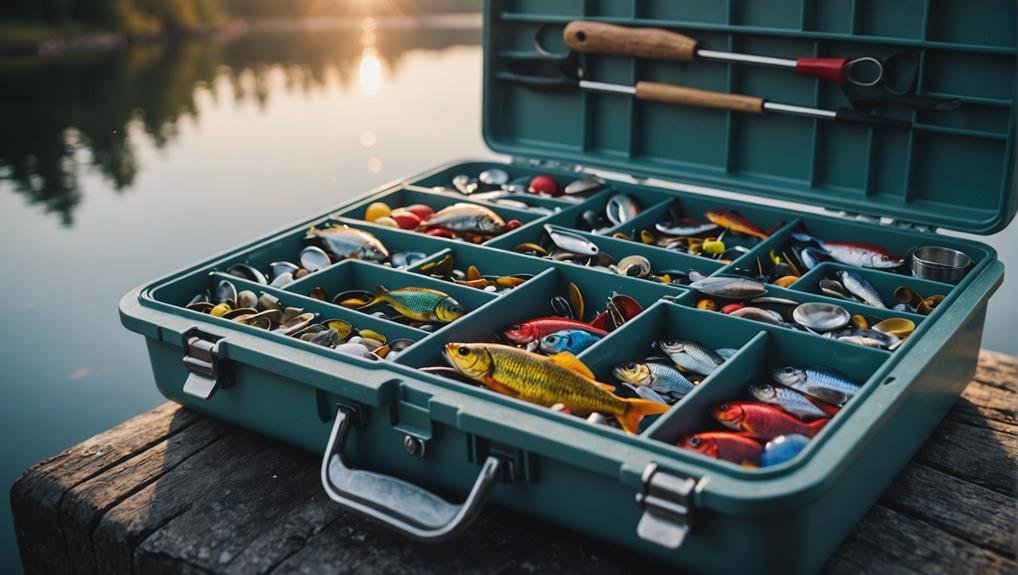
After exploring the effectiveness of soft plastics, let’s turn our attention to jigs and spoons, which are also excellent choices for targeting striped bass. These artificial lures offer unique advantages that can greatly enhance your catch rates.
Jigs are incredibly versatile and can be used in various water conditions. Whether you’re fishing in shallow waters or deep channels, jigs can adapt to the situation. Their ability to mimic the movement of injured baitfish makes them irresistible to striped bass. To maximize your success, experiment with different colors and sizes to see what the fish are biting on that day.
Spoons, however, have a flashy design that immediately grabs the attention of striped bass. The reflective surface mimics the flickering scales of a distressed baitfish, enticing strikes even from a distance. Spoons are particularly effective in clear water where their flash can travel further.
Here are three tips for using jigs and spoons effectively:
- Experiment with Colors: Different water conditions may require different colors to attract striped bass.
- Adjust Sizes: Larger or smaller lures can be more effective depending on the striped bass’s feeding behavior.
- Vary Retrieval Speed: Changing your retrieval speed can better mimic the movement of injured baitfish.
Conclusion
To catch striped bass, don’t hesitate to try a variety of baits and techniques. Live options like bunker, eels, clams, and mackerel mimic their natural prey and can trigger their predatory instincts.
If you prefer artificial lures, topwater options, soft plastics, jigs, and spoons can also be highly effective. You’ll optimize your chances of reeling in these prized game fish by experimenting and adapting to different conditions.
Keep trying, and you’ll find what works best for you.
FAQs
What are the top live baits for catching striped bass?
The top live baits for catching striped bass include:
- Live Eels: Highly effective for catching large striped bass, especially in saltwater and estuarine environments.
- Bunker (Menhaden): Live or chunked, bunker is a popular bait for attracting striped bass.
- Herring: Both live and cut herring work well for striped bass, particularly in rivers and estuaries.
- Shad: Live or cut shad is another excellent bait for striped bass, often used in freshwater and brackish waters.
- Mackerel: Live or cut mackerel is effective in coastal waters where striped bass are feeding.
What artificial lures are best for striped bass fishing?
Effective artificial lures for striped bass fishing include:
- Swimbaits: Soft plastic swimbaits that mimic the movement of baitfish are highly effective.
- Topwater Plugs: Poppers and surface walkers create a commotion on the surface, attracting striped bass to strike.
- Jigs: Bucktail or soft plastic jigs with a weighted head can be used in various depths and conditions.
- Crankbaits: These lures mimic the swimming action of baitfish and are effective for both trolling and casting.
- Spoons: Reflective spoons that mimic the baitfish flash can attract striped bass in deeper waters.
What techniques can enhance the effectiveness of bait for striped bass?
Techniques to enhance the effectiveness of bait for striped bass include:
- Drifting: Drift live bait or lures along current seams, drop-offs, or structures where striped bass are likely to feed.
- Trolling: Troll with live bait or artificial lures to cover more water and locate schools of striped bass.
- Chumming: Use chum to attract and concentrate striped bass in your fishing area. This is especially effective with cut bait.
- Casting and Retrieving: Cast and retrieve lures where you see surface activity or near structures like rocks and piers.
- Bottom Fishing: Use weighted rigs to present bait near the bottom where striped bass may be feeding.
What is the best time of year to use specific baits for striped bass?
The best time of year to use specific baits for striped bass can vary:
- Spring: Live eels, herring, and bunker are effective as striped bass move into rivers and estuaries to spawn.
- Summer: Swimbaits, topwater plugs, and live bait work well in coastal waters and during night fishing.
- Fall: Spoons, jigs, and cut bait are effective as striped bass feed heavily to prepare for winter.
- Winter: Live bait and slow-moving lures can be effective in deeper waters where striped bass may be holding.
Are there local or regional baits that work particularly well for striped bass?
Local or regional baits that work well for striped bass include:
- Sandworms and Bloodworms are effective in many northeastern coastal areas with abundant worms.
- Clams: Fresh or salted clams are popular in areas like the Chesapeake Bay.
- Squid: Effective in coastal waters where squid is a natural prey for striped bass.
Understanding the best baits and techniques for striped bass fishing can significantly improve your success and make your fishing experience more enjoyable. Whether using live bait or artificial lures, matching your approach to striped bass’s conditions and feeding habits is key.
